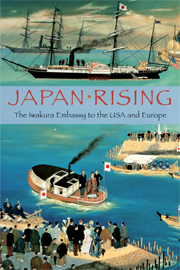Book contents
- Frontmatter
- Contents
- Introduction by Ian Nish
- Note on the Text
- VOLUME I THE UNITED STATES OF AMERICA
- VOLUME II BRITAIN
- VOLUME III CONTINENTAL EUROPE, 1
- VOLUME IV CONTINENTAL EUROPE, 2
- 61 A Survey of Russia
- 62 A Survey of Russian Railways and St. Petersburg
- 63 A Record of St. Petersburg, 1
- 64 A Record of St. Petersburg, 2
- 65 A Record of St. Petersburg, 3
- 66 A Record of Northern Germany, First Part
- 67 A Record of Denmark
- 68 A Record of Sweden, 1
- 69 A Record of Sweden, 2
- 70 A Record of Northern Germany, Second Part, 1
- 71 A Record of Northern Germany, Second Part, 2
- 72 A Record of Southern Germany
- 73 A Survey of Italy
- 74 A Record of Florence
- 75 A Record of Rome, 1
- 76 A Record of Rome, 2
- 77 A Record of Naples
- 78 A Record of Lombardy and Venice
- 79 A Survey of Austria
- 80 Travels by Rail in Austria, and a Survey of Vienna
- 81 A Record of Vienna
- VOLUME V CONTINENTAL EUROPE, 3; AND THE VOYAGE HOME
- Index
64 - A Record of St. Petersburg, 2
Published online by Cambridge University Press: 04 August 2010
- Frontmatter
- Contents
- Introduction by Ian Nish
- Note on the Text
- VOLUME I THE UNITED STATES OF AMERICA
- VOLUME II BRITAIN
- VOLUME III CONTINENTAL EUROPE, 1
- VOLUME IV CONTINENTAL EUROPE, 2
- 61 A Survey of Russia
- 62 A Survey of Russian Railways and St. Petersburg
- 63 A Record of St. Petersburg, 1
- 64 A Record of St. Petersburg, 2
- 65 A Record of St. Petersburg, 3
- 66 A Record of Northern Germany, First Part
- 67 A Record of Denmark
- 68 A Record of Sweden, 1
- 69 A Record of Sweden, 2
- 70 A Record of Northern Germany, Second Part, 1
- 71 A Record of Northern Germany, Second Part, 2
- 72 A Record of Southern Germany
- 73 A Survey of Italy
- 74 A Record of Florence
- 75 A Record of Rome, 1
- 76 A Record of Rome, 2
- 77 A Record of Naples
- 78 A Record of Lombardy and Venice
- 79 A Survey of Austria
- 80 Travels by Rail in Austria, and a Survey of Vienna
- 81 A Record of Vienna
- VOLUME V CONTINENTAL EUROPE, 3; AND THE VOYAGE HOME
- Index
Summary
April 7th, 1873. Cold and overcast; temperature fell to 38°F; flurries of snow.
We went to the Ministry of Foreign Affairs, where there was a reception.
At half past one we went to the bank-note printing works, which is larger than that of any other country. The paper manufactured in the printing works is a different colour on each side and contains watermarks. The design, made of copper (in other words, a mesh made of copper wire), is placed on the wooden frame which holds the paper-making screen and then pressure is applied to the screen to make one side of the paper. Then, after removing the mesh, they pour in paper pulp of a different colour; as a result, paper of a different colour is formed in those parts where the screen was covered, leaving the design clearly visible on the reverse. Once the paper is formed, the screen is placed on a flat piece of flannel to deposit the paper; thus, a pile is gradually built up, and steam-power is used to apply pressure to the paper and the flannel and thereby expel the water. The paper is then dried by steam, and after the sheets of paper have been removed the process is completed (by rolling them between two sheets of copper to give them a sheen, and so on). The paper thus produced is pliant and of excellent quality, but it involves a great deal of labour and is therefore costly.
- Type
- Chapter
- Information
- Japan RisingThe Iwakura Embassy to the USA and Europe, pp. 340 - 345Publisher: Cambridge University PressPrint publication year: 2009



